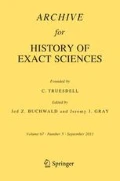References
P.S. Laplace, “Mécanique céleste”. Supplement to the tenth book in vol. IV. Imprim. Imperiale, Paris 1805. Also several later reproductions and reprintings, the latest being the “impression anastaltique”, Bruxelles 1967.
Th. Young, Philos. Trans. 1805 I, 65–87.
J.J. Bikerman, Centaurus 19, 182–206 (1975).
P.S. Laplace, “Mécanique céleste”, Second supplement to the tenth book; see ref. [1].
A.C. Clairaut, “Théorie de la figure de la terre, tirée des principes de l'hydrostatique”, 1743. The German translation by Ph.E.B. Jourdain and A.V. Oettingen, Engelmann, Leipzig 1913 (Ostwald's Klassiker, No. 189) was used here.
J.A. Segner, Commentarii Societ. Regiae Scientiarum Gottingensis 1, 301–372 (1752). The author's name is given only as I.A.S., but the authorship is confirmed, e.g., in Göttingensche Zeitungen von gelehrten Sachen auf das Jahr 1752, p. 1237. Segner was born in Hungary, acquired his Dr. Med. degree in the University of Jena in 1730, and was prof. ord. phys. et mathem. in Göttingen from 1735 to 1755. In 1755 he was knighted by the King of Prussia (thus getting the right of signing his name von Segner rather than Segner) and transferred to the University of Halle [7].
Pütter's “Versuch einer Academischen Gelehrten-Geschichte von der Georg-August Universität zu Göttingen”, 1765, pp. 94–96.
Ref. [6], p. 325. Guttae autem non gravis figuram, qua ejus partes, in aequilibrio constitutae, quiescent, a globi figura diversum non posse, facile perspicitur.
Ref. [6], p. 331. Pendet ergo figura guttarum gravium, quarum sectiones horizontali parallelae 〈circuli〉 sunt, a sola actione ponderis fluidi, ex qua constant, in filamenta verticalia. The word circuli is missing in the original.
Ref. [6], p. 332. Sit ABC sectio guttae per ejus axem DE, ejusque figurae perimeter unum filamentorum guttae verticalium. FH sit horizontalis ea, a qua, demissis ad filamentum ABC verticalibus, ut FB, pressio ... aequatur faco xdx, dicta FB ista, vel quae ei aequalis est DG, x, ac posita g, quod notaverat gravitatem specificam fluidi ... = 1, quod pariter positum est, cum cc, ee, tt quadrata aequalia sumpta fueri ponderibus ... Cum ergo pressio, qua elementum curvae puncto B adjacens extrorsum urgetur, aequalis sit vi sive resistentiae suo id loco retinenti, secundum eandem directionem introrsum agendo: erit xdx=\( - \frac{{ddy}}{{dx}}tt\) tt, hinc xdxds=−ttddy, atque ad fluentes redundo, \(\frac{{xxds}}{{\text{2}}}\)=eeds−ttdy. Valor autem constantis ee reperitur, posita DH, quae est x ad filamenti ABC verticem, =a. Cum enim hoc loco sit dy=ds, erit \(\frac{{aads}}{{\text{2}}}\)=eeds−ttds, & ee=\(\frac{{aa}}{{\text{2}}}\)+tt. Quo suo loco substituto, aequatio figuram sectionis guttae exponens mutatur in hanc: \(\frac{{xxds}}{{\text{2}}}\)=\(\frac{{aads}}{{\text{2}}}\)+ttds−ttdy; sive 2ttdy=aads+2ttds−xxds. Q.E.I.
F. Cajori, “A History of Mathematical Notations”, vol. II, pp. 197–252. The Open Court Publ. Co., Chicago, 1929.
Ref. [6], p. 340. Naque ergo adhuc adfirmare possum tt eandem esse, ad quamvis ejusdem fluidi guttam, sive magna ea, sive parva fuerit. Quod an ita sese habeat an secus, deficiente hic, propter legem attractionis nondum cognitam, ratiocinio, sola docere potest experientia.
Ref. [6], p. 364.
Ref. [6], p. 367. No reference is given by Segner. It is clear, however, that Peter van Musschenbroek (1692–1761) was meant, especially the table on p. 296 of his Physicae experimentalis ... dissertatio. Lugduni batavorum, apud Samuelem Luchtmans, 1729. Musschenbroek was successfully active in other branches of physics as well and was one of the discoverers of the Leyden jar [15].
See, for instance, E. Gerland, “Geschichte der Physik”, p. 698. Oldenburg Verlag, München, 1913.
Ref. [6], p. 362 ... in tabulam redegit filius meus adolescens ...
Ref. [6], p. 305 ...vis egerit ... aequalis ponderi partis fluidi superficiei ABC terminati, quam capit cylindrus vel prisma, cujus basis aequalis est particulae Bb, altitudo autem, ejus distantia BF a plano horizontali assumpto DE.
Ref. [6], p. 336 ...sir r dicatur radius circuli, quamcunque figurarum starum osculantis in puncto, cujus distantia ab horizontali RS est x ...
Gaspard Monge, Histoire de l'académie royale des sciences avec les mémoires ... 1787, pp. 506–529.
See, for instance, Joseph Fayet, “La revolution française et la science”. Marcel Rivière, Paris 1960, pp. 131, 167, 342.
Dr. Young's Reply to the Animadversions of the Edinburgh Reviewers, a pamphlet (1804 or 1805) reprinted in Th. Young, “Miscellaneous Works” (G. Peacock, ed.). Murray, London 1855. Vol. I, p. 192, especially, p. 215.
Th. Young, “A course of lectures on natural philosophy and the mechanical arts”. Joseph Johnson, London 1807. Vol. I., p. 794.
See, for instance, J.J. Bikerman, “Physical Surfaces”. Academic Press, New York 1970, p. 13.
Ref. [21], p. 485 and particularly p. 490.
The article on Cohesion in vol. III of the Supplement to the 4th, 5th, and 6th editions of Encyclopaedia Britannica, 1824, pp. 211–222. This article, signed only by the initials F.O., is supposed to have been written sometime between 1816 and 1823 [26, p. 254].
G. Peacock, “Life of Thomas Young”. Murray, London 1855, p. 31. See also Alexander Wood, “Thomas Young Natural Philosopher”. Univ. Press. Cambridge 1954.
Anonymous, Quarterly Review, Feb. 1809, p. 107. Professor Sydney Ross was kind enough to supply me with a copy of this review.
Th. Young, British Magazine 1800, reprinted in “Miscellaneous Works” [21], vol. I, pp. 99–100.
H. v. Helmholtz, “Selected Writings” (Russel Kahl, ed.). Wesleyan Univ. Press. Middletown 1971, p. 355.
Author information
Authors and Affiliations
Additional information
Communicated by C. Truesdell
Rights and permissions
About this article
Cite this article
Bikerman, J.J. Capillarity before Laplace: Clairaut, Segner, Monge, Young. Arch. Hist. Exact Sci. 18, 103–122 (1978). https://doi.org/10.1007/BF00348143
Received:
Issue Date:
DOI: https://doi.org/10.1007/BF00348143

